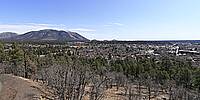
Flagstaff Arizona
Lowell Observatory, Mars Hill, Flagstaff, Coconino County, Arizona, USA
March 22nd, 2024 - 1733 UTC (10:33AM Local)
© 2024 David S. Schaubert, All Rights Reserved.
Most of the city of Flagstaff can be seen from a single overlook just outside the front gates of Lowell Observatory on Mars Hill on the Northwest side of the city. Flagstaff was built by the fortuitous confluence of a rapid rise to Mogollon Plateau that brings snow and rain to the arid desert hills, the Beale wagon trail, the main railroad link into the Los Angeles basin, massive logging of the area Ponderosa Pines, downhill skiing, Route 66, and the proximity of Grand Canyon National Park and numerous other national monuments. The fact that at 7000 feet elevation the average temperatures are 30 degrees (F) cooler than Phoenix 1.5 hours to the South make it a popular destination to get out of the summer heat.
Lowell Observatory is known for the infamous Canals of Mars by Percival Lowell and the discovery of the Planet Pluto by in 1930 by Clyde Tombaugh. Both the Clark Refractor and the Pluto Discovery Astrograph are still active and it is a popular tourist destination. Modern instruments surround the city with the Naval Observatory and Discovery Channel Telescope in the surrounding hills. A 7000' altitude and normally clear skies and easy access make the area ideal for astro research. The city also became the world's first International Dark Sky City in 2001.
Northern Arizona University dominates the center of the city with facilities for 25,000 students mostly from outside the local area (Flagstaff was 76,989 population in 2021)
Lat: 35° 11' 57.37" N
Long: 112° 40' 43.65" W
Precision is: High. Pinpoints the exact spot.
Canon XTi (400D) DSLR, Sigma 8mm f3.5 fisheye lens, Nodal Ninja 3 (NN3) Pano Head, MegaMast 28' Carbon Fiber Stand, Apple 16" MacBook Pro i9 2019, PTGui Pro 11.31, Affinity Photo 2.4.0, Pano2VR 6.1.14


 Tap or click the zoom icon in the bottom right corner of the picture to switch between in-page and fullscreen view
Tap or click the zoom icon in the bottom right corner of the picture to switch between in-page and fullscreen view